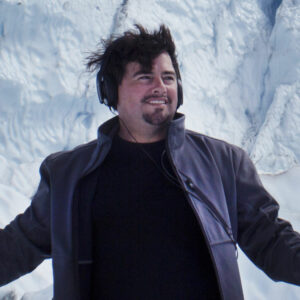Profiled from Atmospheres
Matthew Burtner composer
If someone told you there was music that could lull pillowy-winged moths into a fluttery state of happiness, that the Aurora Borealis can sing even better than you and I, or that the roots of the American elm trees in Central Park are a bustling ensemble waiting for their cue, would you believe them? Matthew Burtner would, and he’d have no trouble proving it on PROFILED FROM ATMOSPHERES, the veteran ecoacoustic composer’s sixth release with Ravello Records. Burtner lifts the veil between humanity and its planet, translating its messages into an intimate medium invariably understood amongst its inhabitants. These messages make an urgent case in the titular work Profiled From Atmospheres, a collaborative work between atmospheric sound profiles derived from humanity’s top three greenhouse gas emissions and saxophone/percussion duo Michael Weiss and Elizabeth Soflin. The result is an eerie, haunting sonification that serves as a poignant reminder; if we want to continue hearing the songs of the atmosphere and the planet it blankets, it’s our responsibility to preserve it.
Listen
Stream/Buy
Choose your platform
Track Listing & Credits
| # | Title | Composer | Performer | |
|---|---|---|---|---|
| 01 | Piece for a Northern Sky (2013) | Matthew Burtner | Matthew Burtner, vibraphone; atmosphere ecoacoustics | 5:03 |
| 02 | Auroras (2022) | Matthew Burtner | northern lights ecoacoustics | 7:31 |
| 03 | Arbor (2023): Mother Tree | Matthew Burtner | Bruno Eicher, violin; Mary Hammann, viola; Sarah Crocker Vonsattel, violin; Kari Jane Docter, cello; tree ecoacoustics | 4:27 |
| 04 | Arbor (2023): Roots | Matthew Burtner | Bruno Eicher, violin; Mary Hammann, viola; Sarah Crocker Vonsattel, violin; Kari Jane Docter, cello; tree ecoacoustics | 2:00 |
| 05 | Arbor (2023): Trunk | Matthew Burtner | Bruno Eicher, violin; Mary Hammann, viola; Sarah Crocker Vonsattel, violin; Kari Jane Docter, cello; tree ecoacoustics | 4:35 |
| 06 | Arbor (2023): Canopy | Matthew Burtner | Bruno Eicher, violin; Mary Hammann, viola; Sarah Crocker Vonsattel, violin; Kari Jane Docter, cello; tree ecoacoustics | 3:03 |
| 07 | Arbor (2023): Stand | Matthew Burtner | Bruno Eicher, violin; Mary Hammann, viola; Sarah Crocker Vonsattel, violin; Kari Jane Docter, cello; tree ecoacoustics | 5:56 |
| 08 | Wind Rose (2016) | Matthew Burtner | Matthew Burtner, acoustics; Jody Sperling, amplified choreography; Time Lapse Dance Ensemble | Frances Barker, Anika Hunter, Maki Kitahara, Nicole Lemelin, Sarah Tracy amplified movement; wind ecoacoustics | 7:16 |
| 09 | Nocturne (Moth Music) (2012) | Matthew Burtner | Matthew Burtner, soprano saxophone; Glen Whitehead, trumpet; signal processor, ultrasonic speakers, noise generator | 8:10 |
| 10 | Profiled from Atmospheres (2017): 1959 | Matthew Burtner | Weiss/Soflin Duo | Michael Weiss, alto saxophone; Elizabeth Soflin, percussion; atmosphere ecoacoustics | 2:57 |
| 11 | Profiled from Atmospheres (2017): 1987 | Matthew Burtner | Weiss/Soflin Duo | Michael Weiss, alto saxophone; Elizabeth Soflin, percussion; atmosphere ecoacoustics | 3:30 |
| 12 | Profiled from Atmospheres (2017): 2015 | Matthew Burtner | Weiss/Soflin Duo | Michael Weiss, alto saxophone; Elizabeth Soflin, percussion; atmosphere ecoacoustics | 2:24 |
| 13 | Profiled from Atmospheres (2017): 2050 | Matthew Burtner | Weiss/Soflin Duo | Michael Weiss, alto saxophone; Elizabeth Soflin, percussion; atmosphere ecoacoustics | 3:28 |
Dedication
“To my mom, Judith, who let me face out into the wind; and my dad, Leslie, who taught me to face it bravely.” — Matthew Burtner
Arbor
Recorded by SoundProof Studios
Profiled from Atmospheres
Recorded by Four/Ten Media
Mastering Melanie Montgomery
Executive Producer Bob Lord
A&R Director Brandon MacNeil
A&R Chris Robinson
VP of Production Jan Košulič
Audio Director Lucas Paquette
VP, Design & Marketing Brett Picknell
Art Director Ryan Harrison
Design Morgan Hauber
Publicity Chelsea Kornago
Digital Marketing Manager Brett Iannucci
Artist Information

Matthew Burtner
Matthew Burtner is an Alaskan-born composer, sound artist, and eco-acoustician whose work explores embodiment, ecology, polytemporality, and noise. His music comfortably crosses boundaries between environmental science and art, philosophy and acoustics, technology and body, and he is a leading practitioner of climate change music and ecoacoustic sound art. As a composer, Burtner seeks out contexts where critical issues of human/nature interaction are addressed, whether in musical contexts, other forms of media, scientific conferences, or political conventions. His music has been performed in concerts around the world and featured by organizations such as NASA, PBS NewsHour, the American Geophysical Union (AGU), the BBC, the U.S. State Department under President Obama, and National Geographic.

